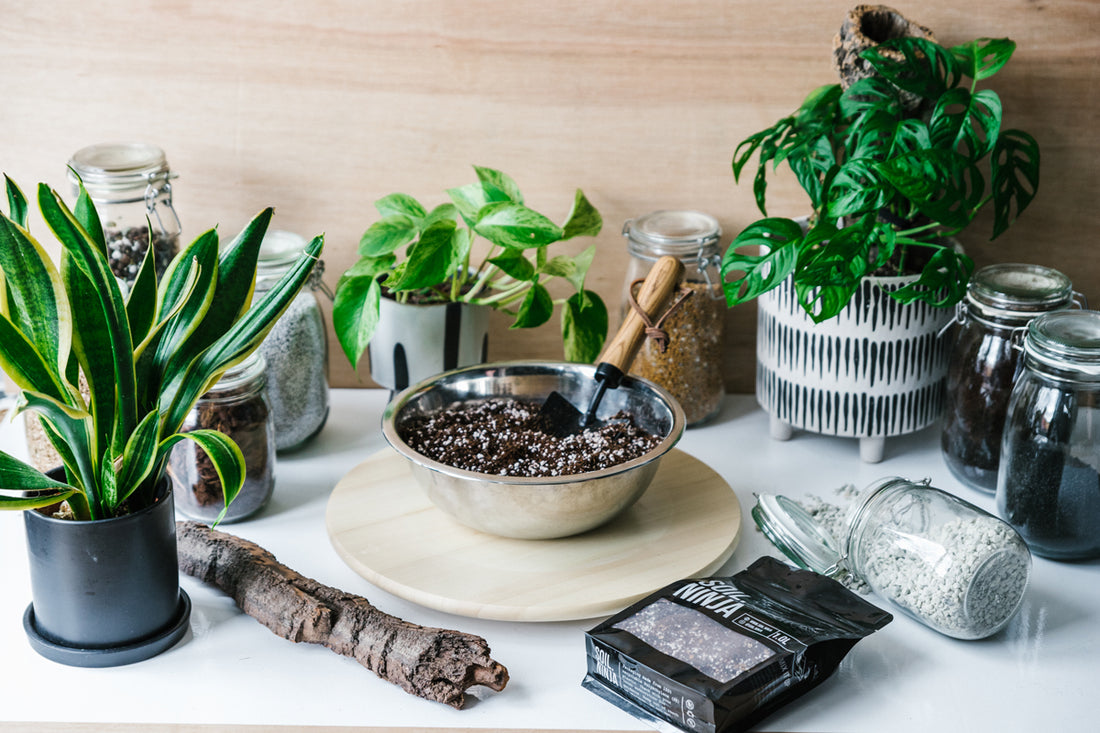
Welcome to our brand new base mix guide for houseplant enthusiasts. In this guide, we will explain what the base mix’s purpose is in our range, the different ways you can use and specialise the blend, with some example recipes to help you get started!
What is the Base mix?
The Base mix has two purposes. Firstly, to act as a basic houseplant soil that is suitable for the majority of plants as long as you are confident in your watering schedule. Secondly, to act as a base that you can add components to which will be more suitable to different plants.
So what do we mean when we say "suitable for the majority of plants as long as you are confident in your watering schedule"? Well, each of our Premium mixes have different properties in terms of water retention that has been suited to the particular plant. For example; our Alocasia mix retains moisture for longer because that’s what Alocasia require (especially when pushing out new growth). Whilst our Cacti and Succulent mix dries fast to mimic the once-in-a-while, short lasting drench they should be getting.
If you were to put all of your houseplants in the unaltered base mix, you would need to be very confident that you are watering appropriately per plant as the mix is no longer helping you out in terms of water retention. If you tend to overwater your plants we would always recommend using amendments with the base mix as this would create a layer of protection. Adding components into your blend not only reassures you that your plant will have a better chance of thriving, but will also reduce the risk of rot.
It's all about how well you can synchronise your waterings with your plants needs, taking into account the soil properties and their environment. If you’re confident in your green thumb, using the base mix as it is, might be something to consider!
Now let’s say you would rather do a bit of specialising to add a layer of protection for your plant! This is where our component guide below will come in handy! The most important thing when it comes to specialising is that you really need to understand what each component does and what its for – once you’ve understood the properties of each ingredient you’ll end up being able to have a lot of fun with creating the perfect mix for you as a grower.
Just a couple points about the base mix itself. Its packed with aerators so root rot shouldn’t be an issue as long as the watering is appropriate. It's also got enough nutrients to last those first couple months of watering, and of course has our same premium buffered Coco coir providing excellent drainage properties.
There are a lot of components out there and gathering information to formulate a blend isn’t always a walk in the park, but no need to worry, we’re here to guide you on your spiritual journey on how to make dirt work!
Component Guide:
• Pumice:
Volcanic material which has expanded in extremely high heat, then ground down into rocks. An aggregate that aerates, stores nutrients and improves drainage. Pumice is a much denser aerator than Perlite, so as well as packing your soil with Oxygen, it won’t float to the top of the pot with each watering!
Use a coarse grade for your chunky rooted plants and a fine grade for the finer rooted plants.
• Bark:
An organic component used for drainage. It is naturally broken down over time, by roots and microbes within a soil blend - therefore creating microbial hotspots. As it breaks down, it releases macro nutrients, this lowers ph substantially. Fine bark will break down a lot faster than coarse. Fine is fantastic for mixing it with young epiphytic plants. Coarse is a lot better for larger pots and roots. It is tremendous for boosting your beneficial fungi, specifically. This is a preferred medium for epiphytes!
Your Anthuriums, Hoyas, Orchids, semi-epiphytic and epiphytes will love this component!
• Zeolite:
An amendment that is revolutionising how we keep soil and other mediums free of toxins! Zeolite has the ability to improve soil structure by improving cation exchange capacity, as well as aerating the soil and acting as a nutrient reserve all at the same time. Zeolite will also absorb and store any built-up ammonia and potassium, seriously reducing the risk of chemical burns and the root rot that commonly follows.
Feel free to use this fantastic components instead of pumice, if you want to switch things up!
• Sand:
Sand creates micro-passages that improves drainage and breaks up denser substrates which is ideal component for plants with complex and small root systems. Sand is an age old soil amendment that provides a superb composition when mixed in well and absorbs very little water due to its particles being relatively large. This will help the soil to dry out faster. Sand will reduce 'clumping' around roots, making it easy to work with and take off when repotting a plant.
Plants that would appreciate sand in their mix include Cacti, Succulents, Ficus and Ferns.
• Grit:
This is a non-porous aggregate that vastly improves drainage and reduces water retention. Grit’s structure lets excess water slide right on by, absorbing virtually no water. Other properties that Grit can add to soil are an improved structural stability due to its heaviness, alongside improving drainage by opening up denser soils with each individual stone.
This components goes hand in hand with plants like Cacti and Succulents.
• Vermiculite:
A golden aerator that has superior water retentive properties, ideal for thirsty plants. Vermiculite regulates water dispersal within the substrate - natural reforming mineral, present in most pockets of the world. This wonderful component acts like a golden mini sponge. This is a perfect amendment for; Calathea, Alocasia and Maranta's, as well as seed starting, because it holds onto natural nutrients as well as having its own.
• Activated Charcoal:
This purifying component has an incredible ability to remove toxins and bad micro-organisms through trapping them in its porous structure. It's extreme porosity will allow air to not only flow freely through it, but cleans any stagnant pockets of air as well! The pH of activated charcoal can vary but tends to be around 6-7.5, making it a great buffer component in a soil with too much alkaline! And just if that wasn’t enough, Activated Charcoals ability to absorb excess water is an extra safety net against overwatering. Adding 10% of this to all of your blends will help give the plant an extra layer of protection!
Now you’ve had a quick run down of the components and how they work, we thought it would be helpful to have a general guide on how to make a similar mix to our iconic blends.
There's no ‘one way’ to mix the perfect blend for your plants and but you may end up formulating a mix that works hand in hand with your environment and watering routine, so good luck and get mixing!
Side note: Its always worth doing some research about your plants! The Substrate can do so much for you, so if you want to give you plant the best chance, research things like;
• What type of environment does it naturally grow in?
• How can you mimic that in your UK home?
• Does it like humidity?
• What light position would it prefer?
Keeping these care elements in mind can help you further understand your plant and what they want, which should then give you all the growth you’ve wished for.
Go on then, get dirty!

